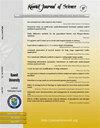Study on the relationship between topological characteristics of vegetation ecospatial network and sand fixation function in the Mongolian Plateau
IF 1.2
4区 综合性期刊
Q3 MULTIDISCIPLINARY SCIENCES
引用次数: 0
Abstract
The spatial structure of vegetation plays a pivotal role in determining the sand fixation function of ecosystems. However, the interaction between vegetation spatial structure at the regional scale and its sand fixation function remains insufficiently understood. Addressing this gap is essential for developing effective strategies to mitigate soil erosion, combat desertification, and enhance ecosystem stability in arid and semi-arid regions. This study investigates the Mongolian Plateau, a region highly vulnerable to wind erosion. Using the minimum cumulative resistance (MCR) model and complex network theory, the regional-scale vegetation structure was abstracted into a vegetation ecospatial network (VEN), and its topological characteristics were analyzed. The revised wind erosion equation (RWEQ) was then applied to estimate soil wind erosion and evaluate vegetation's sand fixation function for 2020. Correlation analysis was conducted to explore the relationships between VEN topological indicators, vegetation-driven sand fixation, and regional wind erosion. The results revealed the 2020 Mongolian Plateau VEN as a scale-free small-world network with strong heterogeneity. Wind erosion modulus of the Mongolian Plateau in 2020 amounted to 33.79 t hm−2, while vegetation sand fixation amount reached 48.68 t hm−2. Most VEN nodes exhibited high sand fixation function. Node sand fixation function exhibited a strong positive correlation with PageRank and a substantial positive correlation with degree and betweenness centrality. These findings can provide insights into optimizing vegetation patterns and enhancing sand fixation function.
蒙古高原植被生态空间网络拓扑特征与固沙功能关系研究
植被的空间结构对生态系统的固沙功能起着举足轻重的作用。然而,区域尺度上植被空间结构与其固沙功能之间的相互作用尚不清楚。解决这一差距对于制定有效战略以减轻干旱和半干旱地区的土壤侵蚀、防治荒漠化和加强生态系统稳定性至关重要。本研究以蒙古高原为研究对象,该地区是风蚀的高发地区。利用最小累积阻力(MCR)模型和复杂网络理论,将区域尺度植被结构抽象为植被生态空间网络(VEN),并对其拓扑特征进行了分析。利用修正后的风蚀方程(RWEQ)估算了2020年土壤风蚀和植被固沙功能。通过相关分析,探讨VEN拓扑指标、植被固沙与区域风蚀的关系。结果表明,2020年蒙古高原VEN是一个具有较强异质性的无尺度小世界网络。2020年蒙古高原风蚀模数为33.79 t hm−2,植被固沙量为48.68 t hm−2。大多数VEN节点表现出较高的固沙功能。节点固沙功能与PageRank呈强正相关,与度和中间度中心性呈显著正相关。研究结果可为优化植被格局和增强固沙功能提供参考。
本文章由计算机程序翻译,如有差异,请以英文原文为准。
求助全文
约1分钟内获得全文
求助全文
来源期刊

Kuwait Journal of Science
MULTIDISCIPLINARY SCIENCES-
CiteScore
1.60
自引率
28.60%
发文量
132
期刊介绍:
Kuwait Journal of Science (KJS) is indexed and abstracted by major publishing houses such as Chemical Abstract, Science Citation Index, Current contents, Mathematics Abstract, Micribiological Abstracts etc. KJS publishes peer-review articles in various fields of Science including Mathematics, Computer Science, Physics, Statistics, Biology, Chemistry and Earth & Environmental Sciences. In addition, it also aims to bring the results of scientific research carried out under a variety of intellectual traditions and organizations to the attention of specialized scholarly readership. As such, the publisher expects the submission of original manuscripts which contain analysis and solutions about important theoretical, empirical and normative issues.
 求助内容:
求助内容: 应助结果提醒方式:
应助结果提醒方式:


